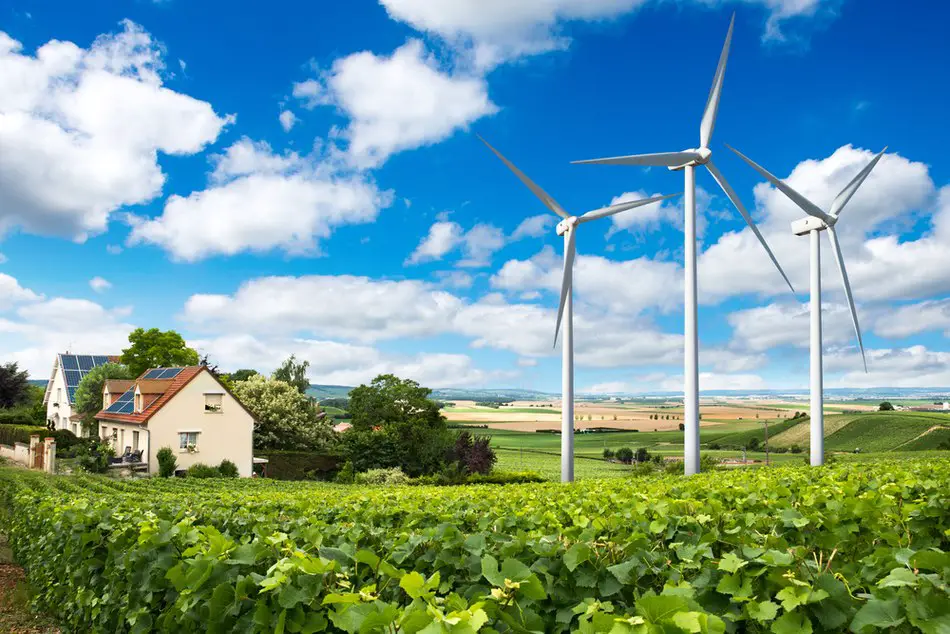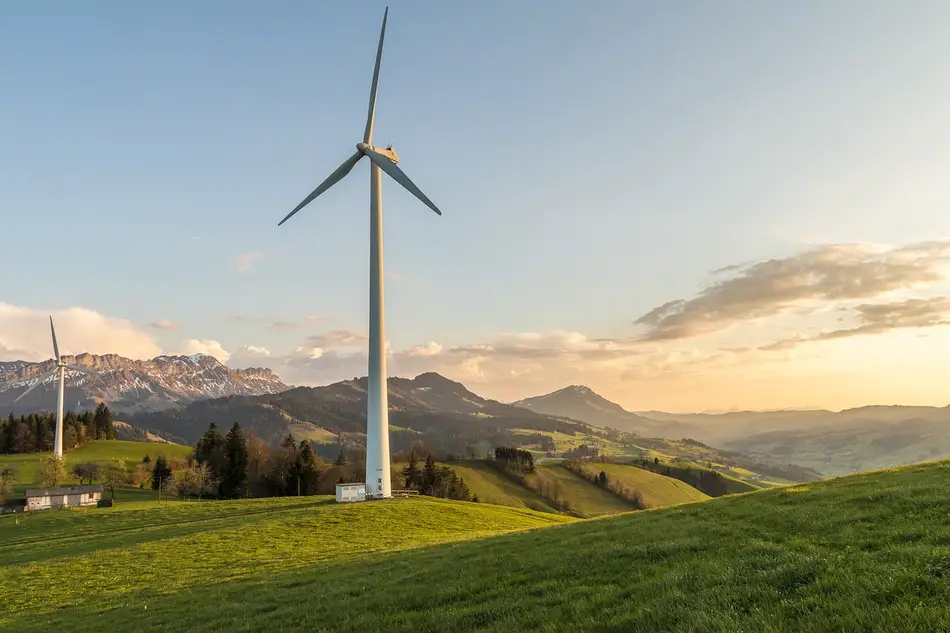The potential in harnessing the wind power to make clean electricity is enormous. If your off-grid property has the right conditions and resources, seriously consider installing a small wind electric system. It has no pollutions and emissions, and all in all is a great source of renewable and free energy.
While the common electric grid can be costly and is prone to outages, especially in remote areas, the reliable and constant wind power can reduce your bills by as much as 90%. You can use it to power your entire home, as well as your farm’s water pumps and irrigation systems.
So how does it work? Basically, our sun heats the earth’s surface unequally, thus creating wind. A wind turbine takes the wind’s kinetic energy and transforms it into electricity. When the blades of the turbine are spun by the wind, a rotor takes this energy and converts into rotary motion that drives the generator.
Many turbines take this system even further and include an automatic overspeed component that deals with high winds. And finally, this setup is either connected by wires to the power provider’s grid, or in our case, directly to the off-the-grid household.
Is Your Area Suitable for a Small Wind Electric System?
Before we even discuss the environment of your property, let’s mention the zoning and permitting issues. Before even considering to install a wind electric system, learn about the local restrictions and consult with the local building inspectors or supervisors. You might need to acquire a building permit.
Additionally, if you live closer to other people, both your neighbors and the laws might object to certain aspects of the wind turbine and its tower. A high tower can obstruct the view, many residential areas insist that the tower’s height shouldn’t exceed 35 feet.
And then there is the noise issue. Usually the sound that a modern wind turbine makes is no louder than the wind itself. This means that you don’t have to worry that you or your neighbors will be bothered by the noise, but always check whether the turbine’s make is considered quiet before you purchase it.
And now to the environment itself. How good is the wind resource in your vicinity? The terrain around you can affect the wind a lot. The wind flow at your location might be quite different from the one only a couple of miles way. Naturally, there are ways to be certain.
- Wind resource map: Yes, such a thing exists. If you live in the USA, there is the Wind Powering America Program maintained by the Department of Energy. It has a map for every state, and you can consult them to see exactly how the wind blows in your area.
- Vegetation flagging: Strong winds affect the vegetation and can provide a strong visual cue regarding the wind speeds around you. For instance, particularly strong winds can noticeably deform the evergreen and conifer trees. This is called “flagging”.
- Local wind systems: An obvious solution, see if there are turbines in your area and get the information from their operators and owners. Ask them how much a system can output in a year, given the local wind speeds.
- Airport: Another potential source of valuable information can be a nearby airport, where they usually track the wind speeds. However, keep in mind that the data does not necessarily reflect the terrain around your household. Also, the airports measure the winds at the average height of 25 feet, while a typical wind tower can be about 80 feet, and the winds at that height are about 20% stronger.
- Measurement system: A do-it-yourself method. To be on the safe side, you can invest about $500 – $1300 into a wind measurement equipment and get a clear picture of the wind resource at your property. This equipment will need to be raised high enough to avoid any obstruction caused by trees, buildings and such – in other words, at the future wind turbine’s height.
Once you’re satisfied with the wind resource, you will need to decide on the exact site for the wind turbine. The turbine’s manufacturer should be able to help you with this decision. First, there should be enough room around the site if the turbine’s tower needs to be lowered and raised for installation and maintenance. Many towers come with guy wires (see below), so there also must be enough room for those. And then there is the electrical wiring, connecting the turbine and the place it serves, such as the house or farming equipment. A long wire causes great losses to the electricity, especially if it’s DC. If a long wire can’t be avoided, then invert DC to AC first.
The terrain’s peculiarities should be also taken into consideration, if you want to make the most of the available wind resource. For instance, if you have a hill, you can install the tower on its top or on its windy side. You must also know the direction in which the wind blows most of the time before making the siting decision. Nearby trees and houses (current or planned to be built in the future) can be an obstacle. The rule of the thumb is that the turbine should be located upwind of any obstacle, and should be 30 feet higher than anything within a radius of 300 feet.
Thanks to the accumulated knowledge and gradual improvement of wind power systems, they have become highly popular in the U.S., as the following video from CNBC shows:
What Are the Wind Systems Made of?
I briefly mentioned earlier some of the components of a typical wind power system, but let’s take a closer look so that you become more familiar with them.
A turbine is usually an upwind machine with horizontal axis. It comes with 2-3 blades made from fiberglass or some other composite material. The turbine’s tail, generator and rotor are attached to its frame. The rotor’s diameter determines just how much energy is produced. A larger rotor, of course, intercepts more wind. The tail part is what ensures that the turbine faces into the blowing wind.
The turbine is mounted on a tower, since the wind speed is higher when you get further away from the ground. You can invest an insignificant amount of money to get an even higher tower, and this investment will quickly pay off thanks to the higher rates of power production. For instance, doubling the tower height can add only about 10% to the total cost of the system, but the power production will be higher by 25%!
The towers are often included in the manufactures systems. There are two types: free-standing (self-supported) towers and guyed towers (steadied by cords or cables). Guyed towers can sometimes come in a tilt-down version. Guyed towers are more common in home wind systems, since they are noticeably cheaper and can be easy to install. Keep in mind that the guy radius is about 1/2 to 3/4 of the tower’s height, so make sure you have enough space for the entire structure.
The tilt-down version costs more, but if you’re running a lightweight, small turbine (about 10 kW), then you can enjoy the advantage of much easier maintenance. Additionally, if a hurricane strikes your area, this type of a tower can be quickly lowered to the ground.
Tip: stay away from the aluminum ones. They crack too easily.
The rest of the parts depend on your wind electric system’s application. The parts needed for a home power supply are not the same as required for water pumps and agriculture. Moreover, the parts depend on whether it’s an off-grid, on-grid or hybrid system.
The wind systems are usually manufactured with everything you need for your own application. In other words, you don’t need to think too hard what parts you must purchase. For example, if you plan to connect your wind system to your house, you can get a package that has all the appropriate parts:
- Tower foundation
- Grounding system
- Wiring
- Disconnect switch
- Inverter
- Storage batteries
- Controller
How to Install and Maintain a Wind Turbine System?
Installation of a wind power system is a challenging issue for a single, untrained person. I would strongly advise that you let the dealer or the manufacturer do all the heavy lifting. The installation requires pouring cement foundation, safely erecting the tower and correctly connecting the DC and AC wiring, as well as the batteries. If you don’t have the appropriate experience and equipment to perform any of these things, then let the professionals do it for you. It’s better than ruining an expensive system that is intended to serve you for many years ahead.
The system maintenance should be performed annually. And again, if you don’t know how to perform these, a licensed and verified technician should be invited. The maintenance normally includes checking the parts for corrosion, checking the guy wires for required tension, tightening bolts and electrical connection and checking the blades. If necessary, blades and bearings are replaced once a decade. Also, the edge tape on the blades should be replaced once a year, if it’s worn.

What Is The Recommended Size of a Wind Turbine?
You know about the wind resource, the location, the system’s part and the maintenance. But just how big of a system you should purchase? This depends on the kilowatt-hours that your house uses. Let’s say that you use about 12,000 kilowatt-hour in a year. A wind turbine that produces 5 to 15 kW should significantly contribute to such a household.
Again, the manufacturer should be your number one source for all these calculations. There are several factors that affect the system’s annual output, such as the tower’s height, the turbine’s power curve, the annual data of the wind speed as well as the number of hours that the wind blows during the year.
Finally, there is a formula that estimates just how big the system’s annual energy output (AEO) can be.
AEO = 0.01328 D² V²
D is the rotor’s diameter in feet, and V is the wind’s yearly average in miles per hour. The end result is in kilowatt-hour per year.
Final Words
Using wind to power your off-grid home is highly recommended, as long as you live in a suitable geographic area. Double-check every factor I mentioned earlier in order to completely ensure you can depend on wind power for all your electrical needs.
Naturally, wind power is not the only type of alternative energy. The popular solar energy can also provide you with the electricity. For more information, please check out my article on off-grid and on-grid solar power.
Utilizing a flowing water source is also a great option. To read how you can produce electrical energy in this way, please see my article on off-grid hydropower.
There are more options to harness natural sources and produce clean, free energy. I cover all of them in my guide for off-grid living.
And finally, if you still haven’t decided on the best location for your off-grid dwelling, see my detailed post on the best places to live off the grid.
Best of luck in your off-grid future and freedom!

